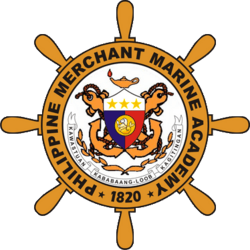Philippine Merchant Marine Academy
| Akademya sa Bapor Pangkalakalan ng Pilipinas | |
 | |
| Motto | Kawastuan, Kababaang Loob, Kagitingan (Righteousness, Humility, Courage) |
|---|---|
| Type | Quasi-Military Academy, State College |
| Established |
April 05, 1820, Intramuros, Manila |
| Location | San Narciso, Zambales, Philippines |
The Philippine Merchant Marine Academy (PMMA) (Filipino: Akademya sa Bapor Pangkalakalan ng Pilipinas) is the Premiere Merchant Marine academy in the Philippines. Operated by the Filipino government under the supervision of the Commission on Higher Education (CHED), the academy is located in San Narciso, in the province of Zambales. Students are called midshipmen but are often also referred to as cadets. Upon graduation students are commissioned as Ensigns (2nd Lieutenants) in the Philippine Navy Reserve. They have the option to start a career in the maritime industry or sign up for active military duty either in the Philippine Navy or the Philippine Coast Guard.
History
The Philippine Merchant Marine Academy stands as one of the oldest and most illustrious institutions in the Philippines today. Originally known as Escuela Nautica de Manila, the PMMA was created by virtue of a Royal Decree issued on January 1, 1820 through the recommendation of the Spanish Consulate of Commerce.
Founded as a school for merchant marine officers, it was inaugurated on April 5 of the same year in its first location inside the Walled City of Intramuros, Manila.
The school was temporarily closed during the Philippine Revolution in 1896 but was reopened by the American authorities on December 15, 1899, recognizing its value as a nautical school. It was called Nautical School of the Philippine Islands.
Later it was again renamed to Philippine Nautical School (PNS), under the supervision of US Navy commanders. All facilities, equipment, and other instructional materials were provided by the government in an effort to raise the standard of the institution. But was closed in 1907 due to lack of support.
In 1913, it was reopened, upon the recommendation of the President of the Shipowner's Association, to answer the urgent need for trained merchant marine officers. It was established as a unit of the Philippine School of Arts and Trades.
With war clouds hovering the Pacific, the PNS was transferred from the Department of Education to the Department of National Defense. But the outbreak of World War II did not see the closure of the school rather, it was expanded into a bigger establishment that included not only training of nautical officers but also of marine engineers and ordinary seamen.
In 1963, Republic Act 3680 converted the PNS into the Philippine Merchant Marine Academy (PMMA), conferring the degree of Bachelor of Science in Marine Transportation (BSMT) major in Navigation and Seamanship or in Steam Engineering and Electricity.
In 1997, the PMMA was placed directly under the supervision of the Commission on Higher Education after being under the Department of Transportation and Communication and complies with the 1995 International Convention on Seafarer's Standards of Training, Certification and Watchkeeping (STCW '95) and the Policies, Standards and Guidelines for Maritime Education of the Commission on Higher Education.
Curriculum
The academy offers courses for Bachelor of Science degrees in marine transportation and marine engineering. Both are four-year residency courses consisting of three-years of academic studies (first, second, and fourth years). The one year apprentice training (third year) is aboard commercial vessels plying the international sea lanes as deck or engine cadets. The academy also offers masters degree courses in shipping business management and maritime education.
The student body is referred to as the Corps of Midshipmen, and follows a rigid seniority system. Each year level is a "class." The fourth-year graduating students are called First Class Midshipmen (1CL), the third year is Second Class Midshipmen (2CL), the second year is Third Class Midshipmen (3CL) and the first year is the Fourth Class Midshipmen.The Fourth Class Midshipmen are also termed as plebes or bugs, while the other classes are termed as upperclassmen. Third Class Midshipmen are also called "Tiger of the Corps", while Second Class Midshipmen sails out of the seven seas around the world on different merchant marine vessels as per their compliance for a 1-year shipboard training aboard international/ocean-going vessels with their rank of Deck Cadet for BSMT Cadets and Engine Cadet for BSMarE Cadets. Lastly, the First Class Midshipmen are also called "King of The Barracks", "Dragon of the Corps" while they aspire to succeed in finishing their 3 years of being a cadet and a graduating class of their year.
Aspiring midshipmen must pass the entrance examinations and rigorous medical and physical examinations before admission. For example, males must be at least five feet three inches tall and have been circumcised, and females must be at least five feet one inch tall and never have given birth. A long list of diseases, including major orthodontic problems and wearing glasses, disqualify both sexes.[1] Successful applicants report to the academy for orientation, a month-long period of indoctrination and training which begins in the approved academic calendar of the following academic year. Probationary Midshipmen or "probies" who pass this orientation & indoctrination trainings undertake an oath-taking ceremony at the end and are assigned serial numbers, given uniforms, and incorporated as Fourth Class Midshipmen.
The curriculum involves both academics and military-style leadership and discipline, aimed at training marine officers to manage coastal and foreign trade, serve as shipping executives, port supervisors, and marine surveyors, and serve as naval officers in time of war or national emergency. The curriculum follows the guidelines of the 1995 STCW and the Policies, Standards and Guidelines for Maritime Education 1997 set by the Commission on Higher Education.
The PMMA is part of the Luzon Science Consortium.